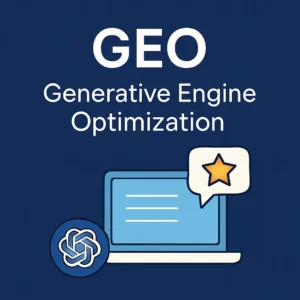For years, SEO has mostly been about one thing: getting found on Google. But the way people search is changing, and so are the platforms they use to do it. With tools like ChatGPT, Perplexity, and Gemini entering the scene, there’s a new kind of optimization taking shape—one that goes beyond traditional search engines. It’s called Generative Engine Optimization (GEO), and it’s quickly becoming a must-know strategy for SaaS founders, app developers, and any digital business trying to stay ahead.

What is Generative Engine Optimization?
Generative Engine Optimization is the process of optimizing your content so that it gets picked up and cited by AI-powered tools that generate responses to user questions—tools like ChatGPT, Claude, and Google’s AI Overviews. Instead of just aiming for a page-one ranking on Google, GEO focuses on being the trusted source these AI tools pull from when giving users answers.
Why does this matter? Because more people are asking questions to AI tools than ever before. If your business isn’t showing up in those responses, you’re missing out on a growing source of traffic and visibility.
Why GEO Matters More in 2025
Search behavior is shifting. A few years ago, everyone typed questions into Google. Now, millions of users are turning to AI platforms for faster, more direct answers. If someone asks ChatGPT “What are the best tools for SaaS analytics?” or “What’s a good SEO agency for app startups?”, these tools don’t show a list of 10 blue links. Instead, they generate a summary, often mentioning specific brands, websites, or resources.
If your content is written well and structured clearly, these models may cite your website. That’s what GEO is about—creating the kind of content that generative engines trust and reference.
GEO vs Traditional SEO: What’s the Difference?
Let’s break this down with a simple comparison:
| Traditional SEO | Generative Engine Optimization |
|---|---|
| Optimized for Google | Optimized for AI assistants (ChatGPT, Gemini, etc.) |
| Focus on keywords, backlinks, technical SEO | Focus on clarity, topical authority, trustworthiness |
| Competes for ranking positions | Competes to be a cited or referenced source |
| Aimed at human searchers | Aimed at language models summarizing info |
GEO doesn’t replace SEO—it builds on it. You still need good technical health, relevant content, and fast-loading pages. But GEO asks: Is your content good enough to be cited by an AI when it tries to explain something to a user?
How to Optimize for Generative Engines
1. Write Clear, Direct Answers
AI models prefer content that is easy to understand and factually solid. If your article takes 400 words to answer a simple question, that’s a red flag. Structure your pages with clear subheadings, use bullet points, and lead with the answer when possible.
For example, if you’re writing a post on “best CRM tools for SaaS startups,” don’t bury the list under a long intro. Give the list early and explain each one briefly.
2. Build Topical Authority
AI tools pull from sources they “trust.” That means websites that consistently publish useful, accurate information on specific topics are more likely to be cited.
If you’re a SaaS founder focused on cybersecurity, create a series of useful guides, explainers, and tutorials in that niche. The more high-quality, topic-specific content you publish, the more likely AI will see you as an authority. That’s where AI-powered SEO services can help—by building structured, relevant content that’s designed to be picked up by generative engines like ChatGPT and Gemini.
3. Be Transparent and Credible
AI models are trained to value trustworthy sources. Include dates, cite your references, and explain where your data comes from. If you quote a statistic or reference a trend, link to the original source. This helps AI engines understand that your content is grounded in real, verifiable info.
4. Create Unique Insights
Most AI tools are trained on common public web data. So if your content just echoes what everyone else says, it might not stand out. What gets noticed are original perspectives—real-world case studies, firsthand experiences, and practical takeaways.
If your team ran a successful SEO campaign for a SaaS client, share the numbers. If you tested five marketing tools and found what worked best, write about it. Originality helps you cut through the noise.
5. Stay Technically Sound
While GEO focuses on content, technical SEO still matters. If your site is slow, hard to navigate, or full of broken links, you risk being ignored—not just by Google but also by the engines training AI.
Make sure your website is mobile-friendly, fast-loading, and structured with clean code. Use schema markup where possible to help engines understand the meaning behind your content.
The GEO Opportunity for SaaS and App Founders
GEO is especially relevant for SaaS founders, app developers, and tech startups. These businesses often compete in crowded spaces and need every edge to get in front of the right audience.
Imagine a potential user asking an AI tool, “What’s the best task management app for remote teams?” If your product or blog gets cited in that response, you’ve skipped the entire funnel—no ads, no organic rankings, just instant visibility at the decision point.
That kind of mention carries weight. When a user sees your name as a recommendation from a tool they trust, it builds credibility fast.
Is GEO the Future of SEO?
Not entirely. Google isn’t going away, and traditional SEO will still matter for years. But GEO is an emerging layer that sits alongside search. Ignoring it means ignoring where users are heading next.
Think of it like this: in the early days of mobile, many companies ignored mobile optimization because desktop still worked. Then suddenly, mobile was the majority. GEO may follow a similar path.
If you’re building a brand, especially in tech or SaaS, this is a channel you can’t afford to overlook.
Getting Started with GEO
You don’t need to overhaul everything to get started with Generative Engine Optimization. Begin by:
- Reviewing your top-performing content: Is it clear, concise, and useful?
- Identifying gaps: What questions are your customers asking that you haven’t answered?
- Creating helpful, trustworthy content with real insight
- Publishing consistently in your niche to build topical authority
And most importantly—write for people first. AI tools are trained to mimic how humans think and learn. If your content feels natural, honest, and helpful, it’s more likely to be picked up.
Final Thoughts
Generative Engine Optimization is about staying visible in a world where search is being reshaped by AI. As users turn to chat-based tools and AI overviews, the way we create content needs to evolve.
For SaaS founders and digital businesses, this is both a challenge and an opportunity. GEO rewards clarity, trust, and originality—traits that align with how great products are built.
Now is the time to adjust your content strategy—not to game the system, but to stay part of the conversation as the future of search takes shape.



